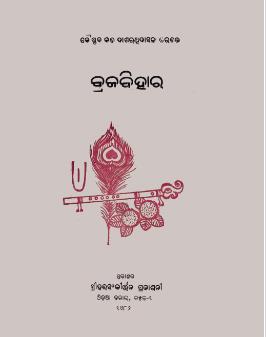In the rich tapestry of Odia literature, one finds itself enchanted by the melodic verses and heartfelt expressions of poets who have shaped the language and its cultural identity. Among them, Dasharathi Das stands out as a pivotal figure, particularly with his celebrated work, Brajabihara, published in 1909. This poetry collection is a significant milestone in the evolution of Odia poetry, reflecting the socio-cultural nuances of its time while embracing timeless themes of love, nature, and devotion.
Brajabihara, whose title translates to The Journey of Braja, is a testament to Das’s deep connection with the essence of his homeland. The collection encapsulates the beauty of rural Odisha, the simplicity of village life, and the profound emotions experienced by its inhabitants. Das’s poetry serves as a window into the life and traditions of Odisha, resonating with readers through its vivid imagery and emotive language.
One of the strongest features of Brajabihara is its ability to paint a picture of the landscapes and lifestyles of Odisha. With descriptive verses that evoke the sights and sounds of nature, Das transports readers to the idyllic villages, lush fields, and serene riverscapes of Odisha. His ability to weave personal experiences with the natural world allows the poetry to resonate on multiple levels, offering both aesthetic pleasure and philosophical introspection.
At the heart of Brajabihara lies a tapestry of themes that celebrate the human experience. Love, devotion, and the connection to nature are recurring motifs, often interwoven with the spiritual undertones characteristic of Odia literature. The sub-poetry within the collection further explores these themes, often focusing on the delicate interplay between love and longing.
Portraying love in its myriad forms, Das captures the nuances of romantic affection as well as the deep bonds of familial and communal relationships. His verses reflect a sense of yearning, a quest for connection that transcends the physical realm, resonating with universal human experiences. This exploration of love is not merely sentimental; it reflects the cultural values of Odisha, emphasizing respect, fidelity, and the celebration of togetherness.
In addition to love, Brajabihara pays homage to devotion, particularly in relation to religion and spiritual practices prevalent in Odisha. Das often draws on symbols and narratives from Hindu mythology, grounding his poetry in cultural heritage while also making it accessible to contemporary audiences. This spiritual dimension adds depth to his work, inviting readers to contemplate their beliefs and the role of faith in everyday life.
The publication of Brajabihara in 1909 marked a significant contribution to Odia poetry, laying the groundwork for future generations of poets. Dasharathi Das’s work inspired others to explore regional themes and cultural identities, forging a path that would see the blossoming of Odia literature in the 20th century and beyond. The collection remains a cherished piece of literary heritage, celebrated for its lyrical beauty and emotional resonance.
In summary, Brajabihara by Dasharathi Das is not just a collection of poems; it is a heartfelt ode to the land, its people, and the myriad emotions that define the human experience. Its rich imagery, profound themes, and cultural significance continue to inspire readers and poets alike, making it a timeless treasure in the realm of Odia literature. As we delve into the verses of Brajabihara, we are reminded of the power of poetry to capture the essence of life, love, and the beauty of our surroundings.
Books Info
| Books name | Brajabihara Part-1 / ବ୍ରଜବିହାର |
| Author | Dasharathi Das |
| No Of pages | 158 |
| Publisher | Sri Sankirtana Prakashani |
| Publication | 1909 |
| Printed At | NA |
| Distributor | NA |

